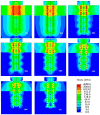Bio-Functional Design, Application and Trends in Metallic Biomaterials
- PMID: 29271916
- PMCID: PMC5795975
- DOI: 10.3390/ijms19010024
Bio-Functional Design, Application and Trends in Metallic Biomaterials
Abstract
Introduction of metals as biomaterials has been known for a long time. In the early development, sufficient strength and suitable mechanical properties were the main considerations for metal implants. With the development of new generations of biomaterials, the concepts of bioactive and biodegradable materials were proposed. Biological function design is very import for metal implants in biomedical applications. Three crucial design criteria are summarized for developing metal implants: (1) mechanical properties that mimic the host tissues; (2) sufficient bioactivities to form bio-bonding between implants and surrounding tissues; and (3) a degradation rate that matches tissue regeneration and biodegradability. This article reviews the development of metal implants and their applications in biomedical engineering. Development trends and future perspectives of metallic biomaterials are also discussed.
Keywords: biodegradable metals; biological function design; biomechanical design; metal implants; porous structure.
Conflict of interest statement
The authors declare no conflict of interest.
Figures











References
-
- Xu G., Fu X., Du C., Ma J., Li Z., Tian P., Zhang T., Ma X. Biomechanical comparison of mono-segment transpedicular fixation with short-segment fixation for treatment of thoracolumbar fractures: A finite element analysis. Proc. Inst. Mech. Eng. J. Part H Eng. Med. 2014;228:1005–1013. doi: 10.1177/0954411914552308. - DOI - PubMed
Publication types
MeSH terms
Substances
LinkOut - more resources
Full Text Sources
Other Literature Sources

